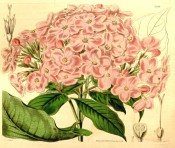Luculia gratissima Sweet
Frost-tender, erect then spreading evergreen or semi-evergreen shrub or small tree, with downy, red-flushed stems, lance-shaped pointed leaves with prominent veins, to 20cm long, and corymbs, to 20cm wide, of fragrant, long-tubed, salverform pink flowers, to 4cm long, from autumn to winter. To 6m. [RHSE, Hilliers’, Hortus].
Horticultural & Botanical History
‘A native of Napal [sic] and Silhet, originally classed with Cinchona. According to Dr. Carey, in Flora Indica, it is a small branching tree, growing to the height of sixteen feet, found on the smaller hills in exposed situations, where it flowers nearly all the year. He says it is impossible to conceive any thing more beautiful than this tree, when covered with its numerous rounded panicles of pink, very fragrant, large blossoms.’ [LBC no.1919/1833].
‘This is one of the most beautiful and most deliciously fragrant of all our winter flowering plants. I am unacquainted with any plant which flowers at this season, and requires so little artificial heat, and so little care generally in its management, which is equal in respect of both beauty and fragrance’. [Gard. Chron. 1852]. ‘It is a matter of surprise that this plant is not grown in every cold greenhouse, for its beauty and fragrance at this season of the year cannot be surpassed’. [Gard. Chron. 1856]. FC p.42/1840. BM t.3946/1842. Introduced to Europe in 1816.
History at Camden Park
Listed in the 1850 and 1857 catalogues [T.652/1850]. Obtained from Kew Gardens, brought out from England by Captain P. P. King in 1849. The plant list entry is marked with a ‘o’, which signifies that Macarthur believed it to be new to the colony. [ML A1980-3]. Macarthur had sought this plant from a number of sources, including it among desiderata to James Backhouse on 10th April 1846 [MP A2933-1, p.136] and 1st February, 1849 [MP A2933-1, p.183]; to Loddiges’ nursery on 6th January 1845 [MP A2933-2, p.28], 16th April 1846 [MP A2933-1, p.147] and 13th February, 1848 [MP A2933-1, p.172]; to John Lindley on 15th February 1848 [MP A2933-1, p.157] and Kew at about the same time [MP A2933-1, p.165] and again to Kew on 1st February, 1849 [MP A2933-1, p.177].
Notes
Another possibility is Luculia gratissima Wall. = Luculia pinceana Hook., which see. Introduced from the Himalayas in 1843, distinguished from L. gratissima by larger, paler flowers. [RHSD]. BM t.4132/1845.
Published Feb 08, 2010 - 12:03 PM | Last updated Feb 08, 2010 - 12:09 PM
| Family | Rubiaceae |
|---|---|
| Category | |
| Region of origin | Himalayas |
| Synonyms | |
| Common Name | Fragrant Luculia |
| Name in the Camden Park Record |
Luculia gratissima |
| Confidence level | medium |


